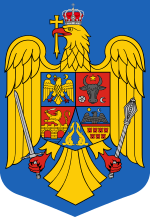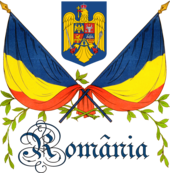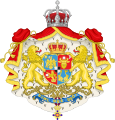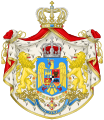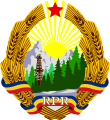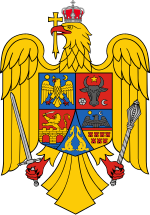
Transylvania is a historical and cultural region in Central Europe, encompassing central Romania. To the east and south its natural border is the Carpathian Mountains and to the west the Apuseni Mountains. Broader definitions of Transylvania also include the western and northwestern Romanian regions of Crișana and Maramureș, and occasionally Banat. Historical Transylvania also includes small parts of neighbouring Western Moldavia and even a small part of south-western neighbouring Bukovina to its north east. The capital of the region is Cluj-Napoca.
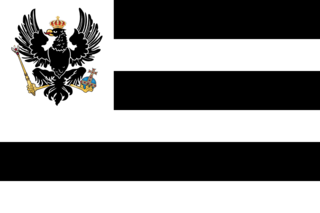
Hohenzollern-Sigmaringen was a principality in southwestern Germany. Its rulers belonged to the senior Swabian branch of the House of Hohenzollern. The Swabian Hohenzollerns were elevated to princes in 1623. The small sovereign state with the capital city of Sigmaringen was annexed to the Kingdom of Prussia in 1850 following the abdication of its sovereign in the wake of the revolutions of 1848, then became part of the newly created Province of Hohenzollern.

Oltenia is a historical province and geographical region of Romania in western Wallachia. It is situated between the Danube, the Southern Carpathians and the Olt river.
The Middle Ages in Romania began shortly after the withdrawal of the Roman legions from the former Roman province of Dacia in the late 3rd century and with the start of the Early Middle Ages and the Migration Period that followed afterwards respectively. It subsequently came to an end with the reign of Domn Michael the Brave (1593–1601) who managed, for a short time between 1599 and 1600, to rule Wallachia, Moldavia, and Transylvania together, the three principalities whose territories were to be united some three centuries later to form modern and contemporary Romania.
The Romanian Old Kingdom is a colloquial term referring to the territory covered by the first independent Romanian nation state, which was composed of the Romanian Principalities: Wallachia and Moldavia. The union of the two principalities was achieved when, under the auspices of the Treaty of Paris (1856), the ad hoc Divans of both countries, which were then under Ottoman Empire suzerainty, voted for Alexander Ioan Cuza as their prince. This process achieved a de facto unification under the name of the United Principalities of Moldavia and Wallachia. The region itself is defined by the result of that political act, followed by the Romanian War of Independence, the inclusion of Northern Dobruja and the transfer of the southern part of Bessarabia to the Russian Empire in 1878, the proclamation of the Kingdom of Romania in 1881, and the annexation of Southern Dobruja in 1913.
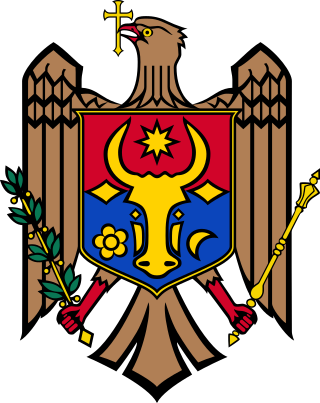
The coat of arms of Moldova is the national emblem of the Republic of Moldova.

The historical regions of Romania are located in Central, Southeastern, and Eastern Europe. Romania came into being through the unification of two principalities, Wallachia and Moldavia in 1862. The new unitary state extended over further regions at various times during the late 19th and 20th centuries, including Dobruja in 1878, and Transylvania in 1918.

The flag and coat of arms of Transylvania were granted by Maria Theresa in 1765, when she established a Grand Principality within the Habsburg monarchy. While neither symbol has official status in present-day Romania, the coat of arms is marshalled within the national Romanian arms; it was also for decades a component of the Hungarian arms. In its upper half, it prominently includes the eagle, which may have been one of the oldest regional symbols, or is otherwise a localized version of the Polish eagle. Early versions of the Transylvanian charges were first designed in Habsburg Hungary at some point before 1550, and were therefore symbols of pretence.

The flag and coat of arms of Moldavia, one of the two Danubian Principalities, together with Wallachia, which formed the basis for the Romanian state, were subject to numerous changes throughout their history.

Ținutul Someș was one of the ten ținuturi ("lands") of Romania, founded in 1938 after King Carol II initiated an institutional reform by modifying the 1923 Constitution and the law of territorial administration. It comprised parts of Transylvania, and included the entire regions of Crișana and Maramureș. It was named after the rivers Someș, Crișul Alb, Crișul Negru, and Crișul Repede; its capital was the city of Cluj. Ținutul Someș ceased to exist de facto following the territorial losses of Romania to Hungary in 1940, and de jure on 22 September 1940.

The Romanian government is the armiger in Romania. It exercises this right under the mandatory advice of the National Committee of Heraldry, Genealogy and Sigillography. The committee is subordinate to the Romanian Academy. All the coats of arms of Romanian institutions must be approved by this committee with two exceptions. The Romanian military is subject to the Ministry of National Defense Heraldric Committee, and Romanian law enforcement institutions are subject to the Ministry of Administration and Interior Heraldric Committee. Both of these committees may share members with the National Committee of Heraldry, Genealogy and Sigillography.
The Romanian dialects are the several regional varieties of the Romanian language (Daco-Romanian). The dialects are divided into two types, northern and southern, but further subdivisions are less clear, so the number of dialects varies between two and occasionally twenty. Most recent works seem to favor a number of three clear dialects, corresponding to the regions of Wallachia, Moldavia, and Banat, and an additional group of varieties covering the remainder of Transylvania, two of which are more clearly distinguished, in Crișana and Maramureș, that is, a total of five.

The current coat of arms of Timișoara was adopted in 1995 and modified in 2009.

Romanian dress refers to the traditional clothing worn by Romanians, who live primarily in Romania and Moldova, with smaller communities in Ukraine and Serbia. Today, the vast majority of Romanians wear modern-style dress on most occasions, and the garments described here largely fell out of use during the 20th century. However, they can still be seen in more remote areas, on special occasions, and at ethnographic and folk events. Each historical region has its own specific variety of costumes.

The following outline is provided as an overview of and topical guide to Romania:

The colors of the national flag of Romania has a long history, though the association of the three colors only dates to the 18th century. Red, yellow and blue were found on late 16th-century royal grants of Michael the Brave, as well as shields and banners. Thus, the late 13th century Wijnbergen armorial shows the coat of arms of the Wallachian ruler Litovoi as consisting of a shield of ten vertically alternating gold-and-red bands,. The same two colors, gules and or, also appeared on the late 15th century flag and coat of arms of Moldavia, during the reign of Stephen the Great. Then, from the late 16th century until the mid-17th century, the historical coat of arms of Transylvania gradually developed as a shield party per fess, consisting of a black eagle on blue background in the upper field, a dividing red band in the middle, and seven red towers on golden background in the lower field. Finally, in the last quarter of the 18th century, Bukovina gets its own coat of arms from the Habsburg Empire, a blue-and-red shield party per pale with a black aurochs' head in the middle, and three golden six-pointed stars surrounding it. During the Wallachian uprising of 1821, these three colors were present, along others, on the canvas of the revolutionaries' flag and its fringes; for the first time a meaning was attributed to them: "Liberty (blue-sky), Justice, Fraternity ( blood)".
The Transylvanian varieties of Romanian are a group of dialects of the Romanian language (Daco-Romanian). These varieties cover the historical region of Transylvania, except several large areas along the edges towards the neighboring dialects.

The territorial evolution of Romania includes all the changes in the country's borders from its formation to the present day. The precedents of Romania as an independent state can be traced back to the 14th century, when the principalities of Moldavia and Wallachia were founded. Wallachia during its history lost several portions of its territory, either to the Ottomans or the Habsburgs. However, this land would be later essentially recovered in its entirety. Moldavia, on the other hand, suffered great territorial losses. In 1774, the Habsburgs invaded Bukovina and annexed it one year later, and in 1812, the Russian Empire took control of Bessarabia. Both territories were later exposed to powerful colonization policies. The principalities declared unification in 1859 as the Principality of Romania. This new state sought independence from the Ottoman Empire's vassalage, and in 1878, it fought a war against it alongside Russia. However, the latter would annex Southern Bessarabia, which was recovered decades before. Romania received Northern Dobruja as compensation, and would wage a war for the southern part against Bulgaria in 1913.
